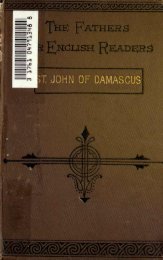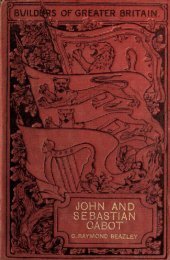A history of Telugu literature; - Cristo Raul
A history of Telugu literature; - Cristo Raul
A history of Telugu literature; - Cristo Raul
You also want an ePaper? Increase the reach of your titles
YUMPU automatically turns print PDFs into web optimized ePapers that Google loves.
HISTORICAL AND RELIGIOUS BACKGROUND 27<br />
literary activity in <strong>Telugu</strong>. The <strong>literature</strong> <strong>of</strong> the period is<br />
known as the Southern School <strong>of</strong> <strong>Telugu</strong> <strong>literature</strong>.<br />
The eighteenth century was marked by the wars between<br />
the French and the English. An event that has left a deep<br />
mark on the people and <strong>literature</strong> <strong>of</strong> the times is the struggle<br />
between the Marquis de Bussey, one <strong>of</strong> Dupleix's ablest<br />
subordinates, and the king <strong>of</strong> modern Vijayanagar in 1757.<br />
The story forms the subject-matter <strong>of</strong> Dittakavi Narayana's<br />
Rangaraya Charitra, A.D. 1790, a popular version <strong>of</strong> which<br />
is still sung by troubadors all through the country. The<br />
issue <strong>of</strong> the struggle with the French was that the British<br />
power was finally established in South India. The Moghul<br />
Emperor, Shah-Alam, granted them the Dewani <strong>of</strong> Bengal,<br />
Behar, Orissa and the Northern Circars in 1764. In 1858,<br />
the Government <strong>of</strong> India was vested in the British Crown.<br />
The latter portion <strong>of</strong> the nineteenth and the beginning <strong>of</strong> the<br />
twentieth century are marked by the absorption <strong>of</strong> Western<br />
culture by the Andhras, and the birth <strong>of</strong> the modern<br />
renaissance in <strong>Telugu</strong> <strong>literature</strong>.<br />
The position <strong>of</strong> internal affairs, between the fall <strong>of</strong> the<br />
empire <strong>of</strong> Vijayanagar and the establishment <strong>of</strong> the British<br />
dominion, deserves notice, as it is with these conditions that<br />
<strong>Telugu</strong> <strong>literature</strong> is closely associated. The march and<br />
counter-march <strong>of</strong> the Muhammadan armies, the struggles <strong>of</strong><br />
the French and the British, did not touch the <strong>Telugu</strong> poet so<br />
intimately as the rise and fall <strong>of</strong> minor principalities. During<br />
the rule <strong>of</strong> the Muhammadans and the British, the country<br />
was divided among Zamindars, some <strong>of</strong> whom were Reddis<br />
and others Padmanayaks. These practically held their territory<br />
under the sovereigns <strong>of</strong> the day. Of these, the Rajas<br />
<strong>of</strong> Vehkatagiri, Bobbili, Pithapur and Vijayanagar deserve<br />
mention as the special patrons <strong>of</strong> <strong>literature</strong> from the<br />
seventeenth century up to the present time.<br />
Religious Background. In order to follow the religious<br />
motive in <strong>Telugu</strong> <strong>literature</strong>, it is necessary to have<br />
a broad idea <strong>of</strong> the nature <strong>of</strong> the original faith <strong>of</strong> the<br />
<strong>Telugu</strong>s, and the subsequent modifications which it<br />
underwent. The Supreme Being is regarded as having<br />
manifested in a Trinity <strong>of</strong> Power, Creation (Srishti)^<br />
Maintenance (Sthiti) and Destruction (Laya), personified in

















